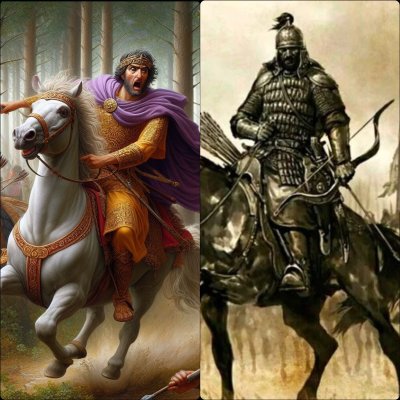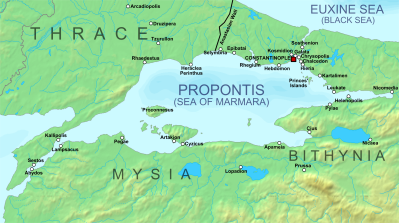
BACKGROUND: Avar Negotiation Tactics!
Amidst the great final war with the Persians, “Herakleios had to return to Constantinople following disturbing news concerning the Avars, who probably did not break the peace openly and only threatened with a new invasion.” He returned to Constantinople, and started negotiating. “In the spring of 623, the Avars openly broke the peace and invaded Thrace.” The most likely issue in contention between the Romans and the barbarians was an Avar demand for increased tribute payments. The Romans were in between a rock and a hard place with the Persian invasions – and the Avars wisely wanted to take advantage of that.

“Herakleios agreed that the upcoming negotiation would not take place in Constantinople. Instead of showing off his military power, the emperor chose to impress the Avars with a pompous ceremony full of spectacularly dressed-up court dignitaries. He most likely decided that the meeting should take place in Herakleia on the Marmara coast on Sunday, 5 June.” The Emperor planned chariot races, and a kind of festival atmosphere with all kinds of performers which one might normally see on display in the Hippodrome of Constantinople.
However, the Avar Khagan was not here to watch chariot races or be dazzled by Roman luxuries. He probably saw all of this as weakness and a lucrative opportunity. Thus, Herakleios “almost fell into a trap. In all likelihood, the Khagan ordered selected troops to scatter into the difficult terrain and cut off the escape corridor for the emperor.” Avar troops then tried to seize the Emperor, which would have been absolutely disastrous for a state in existential crisis. “Herakleios was shocked, but he managed to avoid panicking” and ultimately was able to escape to the safety of Constantinople.
However, not all were so lucky. “For the rest of the day and the following night, the inhabitants of Constantinople witnessed the cruel destruction of the city’s suburbs. The Avar cavalry managed to reach the area of the Golden Horn, where they pillaged the sacral complex of Saints Kosmas and Damianos. Another part reached the Bosphorus and pillaged the Church of the Archangel Michael at Promotos. Herakleios probably tried to persuade the raiders to withdraw from the suburbs by offering them money. The Avars, burdened by loot and a multitude of captives, tried to withdraw as soon as possible to safe territory across the Danube.” Many performers in the planned spectacles for the Avars were also hauled away as prisoners.
This has to be seen as an Avar victory, they were able to loot Thrace and then they also got the deal they wanted. “At the end of 623, Herakleios sent envoys to the Avars asking for peace. The khagan demanded that the tribute be increased to 200,000 solidi. This was an enormous sum, much higher than any previously agreed, even more than the Hun leader Attila had received for refraining from attacking the Roman Empire at the peak of his power. In addition, Herakleios had to hand over several valuable hostages to the Avars to guarantee the fulfillment of the peace treaty.”
Regardless of the setback, Heraclius was able to use this peace to his advantage against the Persians to win the war in the East – but first there would be an Avar attack on Constantinople, which the Persians naturally supported.
THE ARRIVAL OF THE AVARS:

When the Avar army arrived in front of Constantinople in 626, “the terrified inhabitants watched the closed ranks of the barbarians demonstratively marching in shiny armour.” However, the Patriarch Sergios responded and “organized a spectacular procession along the city walls on the same day. In the presence of the clergy and the majority of the population, he showed the enemy an image of Christ the Saviour.”
THE SIEGE:
“In the hot summer days of 626” the Roman capital, Constantinople, “was besieged by a huge horde of the Avars, Slavs, Bulgars, and others from land and sea. Moreover, the allied Persian army, led by the victorious commander Shahrbaraz, stood on the opposite side of the Bosphorus, ready to engage.”
Heraclius had paid the Avars for peace so that in 624 he could on a last-ditch offensive campaign against the Persians to save the crumbling Roman Empire. In 626 “the decisive phase of the last great war of antiquity began.” The Persian king Khusro “wished to finish the whole conflict with one huge offensive in Asia Minor.” He mobilized all available warriors for this purpose. It was clear if Constantinople could fall, then the Romans would have nowhere to hide and Heraclius would have no home left to fight for!

In 626, not only were the Persians mobilizing their forces, but “the Avars mobilized the largest military force in their history” to aim it towards Constantinople. It is not clear exactly how the siege was coordinated between the Avars and Persians, but it is abundantly clear they had worked out a deal. “Were the Persians really interested in participating directly in the siege of Constantinople? Apparently not, because otherwise, they would have organized the naval forces in the ports in the eastern part of the Mediterranean Sea under their control.” Though they did not possess a fleet which could contest the Romans in direct battle, they could used it to ferry troops and harass the Roman fleet.

The battle was not nearly as fierce as the Arab siege of 717 or the 1204 siege by the crusaders, but there was some fighting. The Avars demonstrated that despite being barbarians they could implement proper siege capabilities. “Contemporary sources of the Avar siege explicitly mention protective shields, siege towers, and catapults. During this attack the Avars built siege engines right on the spot from the material brought on wagons.” They likely used protective shields “as a cover for filling the ditch in front of the walls.” The siege towers however, were not very effective and were mostly used from a distance to fight the defenders on the walls. The Avars catapults did damage to the defenders. After three days of construction, “several catapults started to operate and rest of them were in use in the early hours of the following day.”

There was an attempt to attack Constantinople by sea, however it was definitely the least impressive component of the Avar forces. “The Avars tried to approach he capital from the Golden Horn in simple boats, each made from a single tree trunk.” But they did have numbers on their side. “The Latin author Anastasius Bibliothecarius and the Byzantine chronicler George Kedrenos had access to a better version of Theophanes’s chronicle. They both mention that ‘the Avars brought from the Istros an innumerable amount of boats, indeed beyond any count.’” The Romans always maintained control of the sea in this war though, and Heraclius was easily able to send reinforcements from his army to Constantinople by sea. The navy kept the Persians from being able to seriously get involved in the battle.
The diplomacy in this era is very complicated for all parties who had their own goals. “Khusro had a great interest in stopping further attacks of the Roman army.” But the Avars “might have worried about the result of this long war. If the Eastern Roman Empire lost it and ceased to exist, there would have been no one left to pay them.” If the Romans won, the Avars “faced the risk that Herakelios would decided to end their military and political hegemony in the Balkans.” The Avars had their own issues with Slavic rebellions as well.
A reasonable analysis might conclude that the Avars likely wanted to use the siege as a means to force Heraclius to pay even more to them. “However, he and his followers certainly did not want to occupy the city or establish the new centre of power. They rushed to the Bosporus only for the chance of booty and their own fame.”
SOURCES:
The Avar Siege of Constantinople in 626: History and Legend by Martin Hurbanic.

